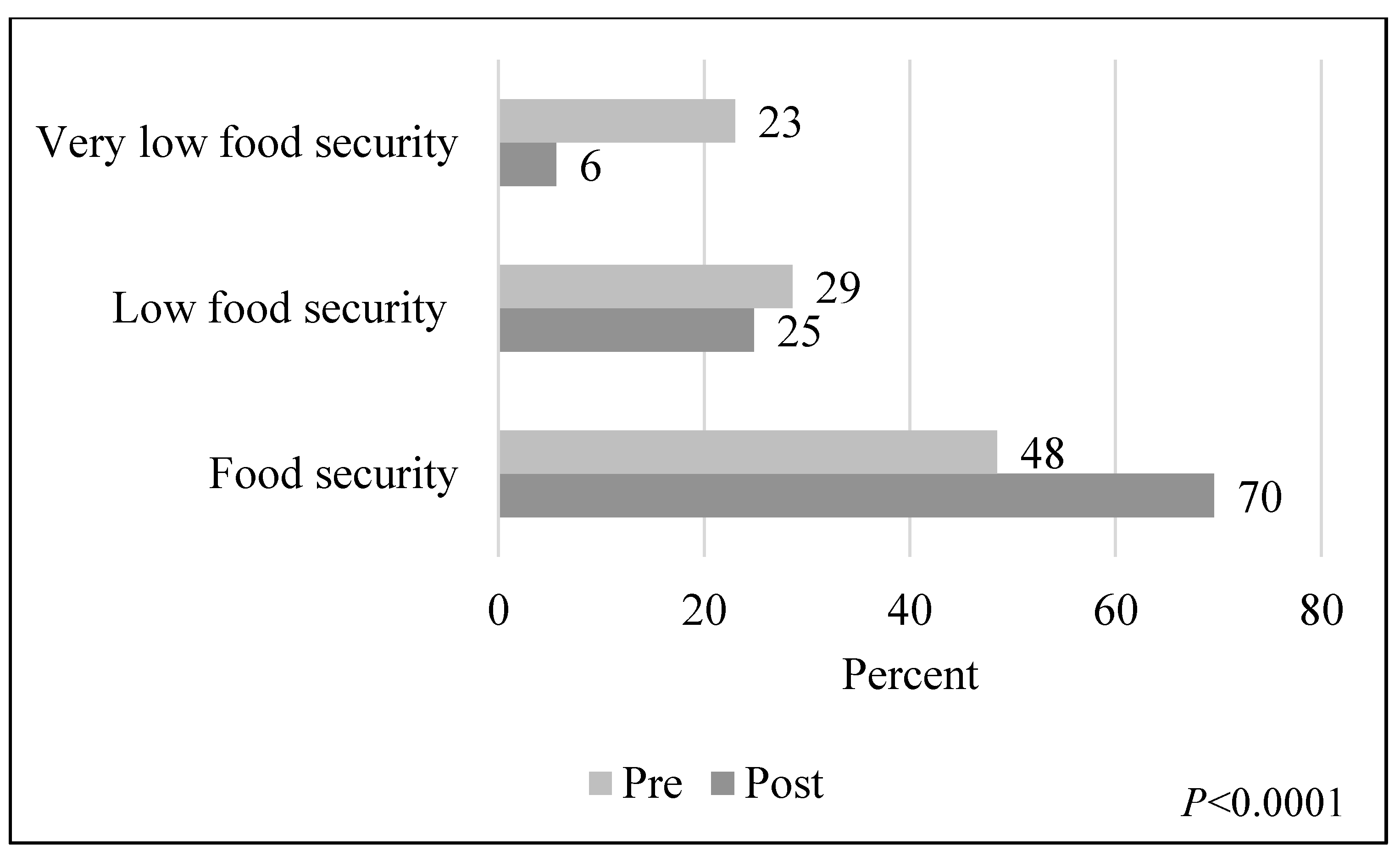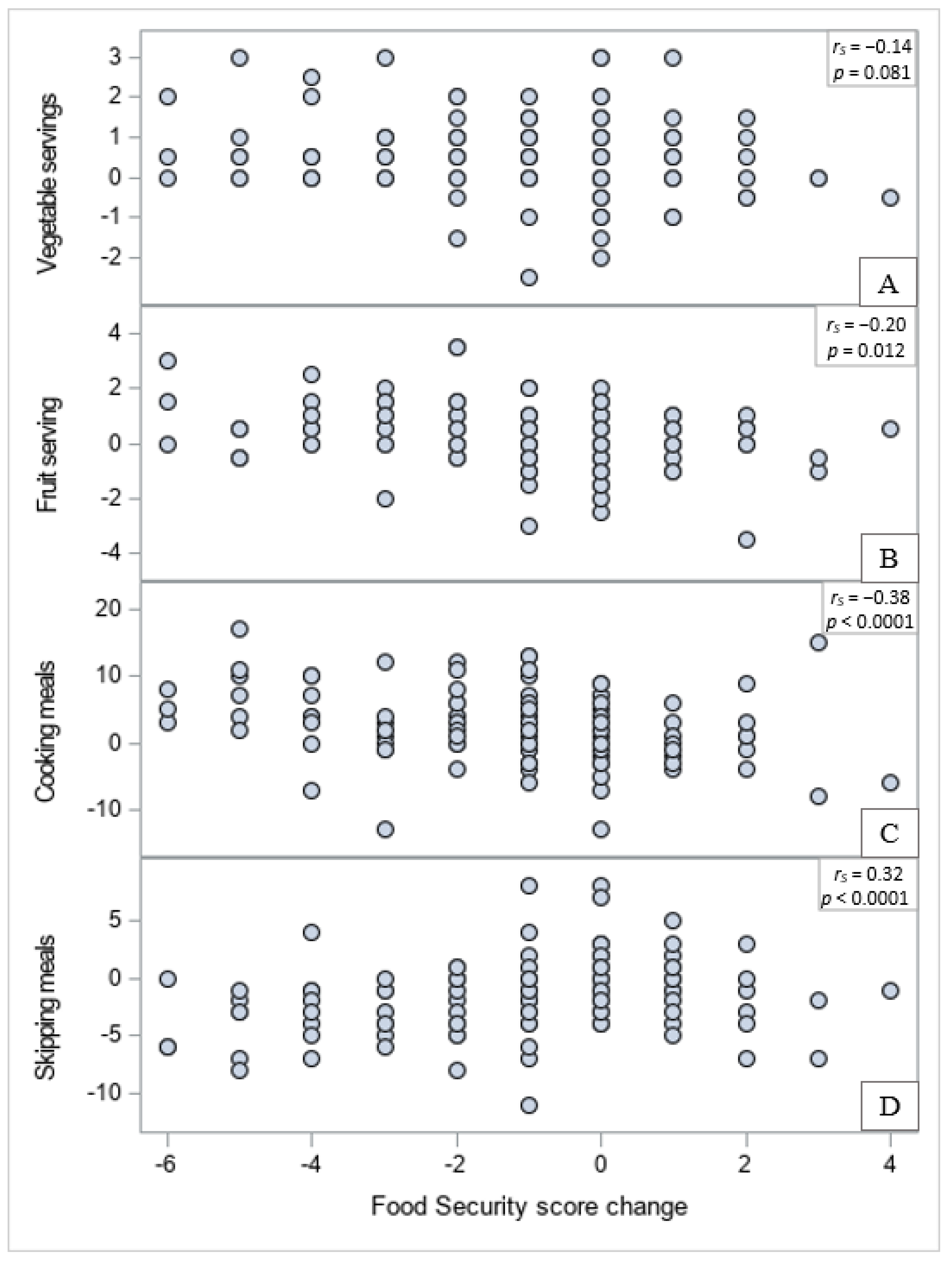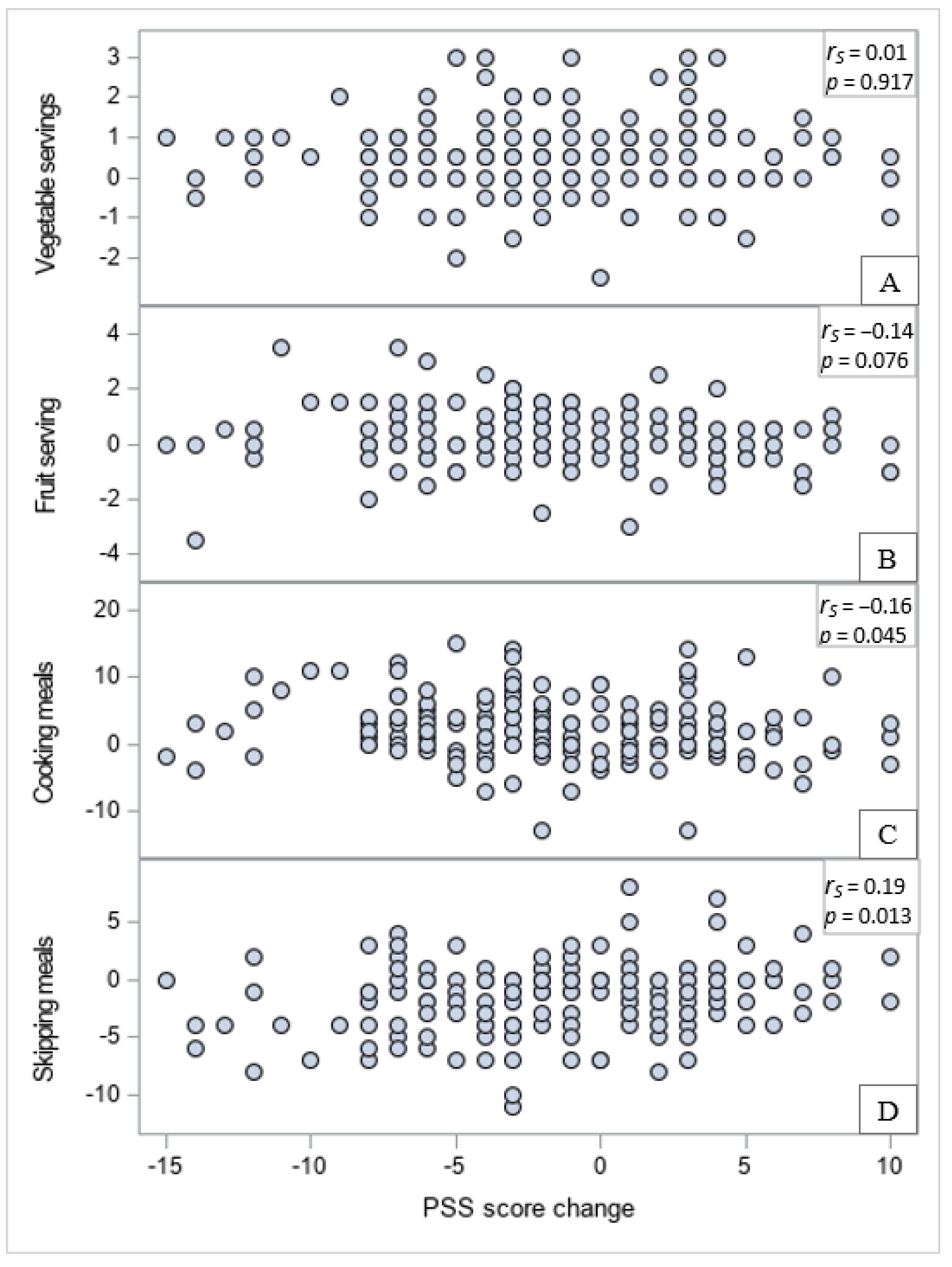Integrated Nutrition and Culinary Education in Response to Food Insecurity in a Public University
Abstract
:1. Introduction
2. Materials and Methods
2.1. Study Design
2.2. Intervention
2.3. Participants and Recruitment
2.4. Data Collection
2.5. Data Analysis
3. Results
4. Discussion
Author Contributions
Funding
Institutional Review Board Statement
Informed Consent Statement
Data Availability Statement
Acknowledgments
Conflicts of Interest
References
- Coleman-Jensen, A.; Rabbitt, M.P.; Gregory, C.A.; Singh, A. Household Food Security in the United States in 2019; ERR-275; US Department of Agriculture, Economic Research Service, 2020; Available online: https://www.ers.usda.gov/webdocs/publications/99282/err-275.pdf (accessed on 3 July 2021).
- Bruening, M.; Argo, K.; Payne-Sturges, D.; Laska, M.N. The Struggle Is Real: A Systematic Review of Food Insecurity on Postsecondary Education Campuses. J. Acad. Nutr. Diet. 2017, 117, 1767–1791. [Google Scholar] [CrossRef]
- Martinez, S.M.; Maynard, K.; Ricthie, L.D. Student Food Access and Security Study; University of California Global Food Initiative, 2016; Available online: https://regents.universityofcalifornia.edu/regmeet/july16/e1attach.pdf (accessed on 3 July 2021).
- Nikolaus, C.J.; An, R.; Ellison, B.; Nickols-Richardson, S.M. Food Insecurity among College Students in the United States: A Scoping Review. Adv. Nutr. 2020, 11, 327–348. [Google Scholar] [CrossRef]
- Coleman-Jensen, A.; Rabbitt, M.P.; Gregory, C.A.; Singh, A. Household Food Security in the United States in 2015; ERR-215; US Department of Agriculture, Economic Research Service, 2016; Available online: https://www.ers.usda.gov/webdocs/publications/79761/err-215.pdf (accessed on 3 July 2021).
- Laraia, B.A. Food insecurity and chronic disease. Adv. Nutr. 2013, 4, 203–212. [Google Scholar] [CrossRef] [PubMed] [Green Version]
- Park, C.Y.; Eicher-Miller, H.A. Iron Deficiency Is Associated with Food Insecurity in Pregnant Females in the United States: National Health and Nutrition Examination Survey 1999-2010. J. Acad. Nutr. Diet. 2014, 114, 1967–1973. [Google Scholar] [CrossRef]
- Seligman, H.K.; Bindman, A.B.; Vittinghoff, E.; Kanaya, A.M.; Kushel, M.B. Food Insecurity is Associated with Diabetes Mellitus: Results from the National Health Examination and Nutrition Examination Survey (NHANES) 1999–2002. J. Gen. Intern. Med. 2007, 22, 1018–1023. [Google Scholar] [CrossRef] [PubMed] [Green Version]
- Seligman, H.K.; Laraia, B.A.; Kushel, M.B. Food insecurity is associated with chronic disease among low-income NHANES participants. J. Nutr. 2010, 140, 304–310. [Google Scholar] [CrossRef] [PubMed] [Green Version]
- Nagata, J.M.; Palar, K.; Gooding, H.C.; Garber, A.K.; Bibbins-Domingo, K.; Weiser, S.D. Food Insecurity and Chronic Disease in US Young Adults: Findings from the National Longitudinal Study of Adolescent to Adult Health. J. Gen. Intern. Med. 2019, 34, 2756–2762. [Google Scholar] [CrossRef] [PubMed]
- Golovaty, I.; Tien, P.C.; Price, J.C.; Sheira, L.; Seligman, H.; Weiser, S.D. Food Insecurity May Be an Independent Risk Factor Associated with Nonalcoholic Fatty Liver Disease among Low-Income Adults in the United States. J. Nutr. 2020, 150, 91–98. [Google Scholar] [CrossRef]
- Maynard, M.; Andrade, L.; Packull-McCormick, S.; Perlman, C.M.; Leos-Toro, C.; Kirkpatrick, S.I. Food Insecurity and Mental Health among Females in High-Income Countries. Int. J. Environ. Res. Public Health 2018, 15, 1424. [Google Scholar] [CrossRef] [Green Version]
- Hromi-Fiedler, A.; Bermúdez-Millán, A.; Segura-Pérez, S.; Pérez-Escamilla, R. Household food insecurity is associated with depressive symptoms among low-income pregnant Latinas. Matern. Child Nutr. 2011, 7, 421–430. [Google Scholar] [CrossRef] [Green Version]
- Martinez, S.M.; Webb, K.; Frongillo, E.A.; Ritchie, L.D. Food insecurity in California’s public university system: What are the risk factors? J. Hunger. Environ. Nutr. 2018, 13, 1–18. [Google Scholar] [CrossRef]
- Leung, C.W.; Wolfson, J.A.; Lahne, J.; Barry, M.R.; Kasper, N.; Cohen, A.J. Associations between Food Security Status and Diet-Related Outcomes among Students at a Large, Public Midwestern University. J. Acad. Nutr. Diet. 2019, 119, 1623–1631. [Google Scholar] [CrossRef]
- Mirabitur, E.; Peterson, K.E.; Rathz, C.; Matlen, S.; Kasper, N. Predictors of college-student food security and fruit and vegetable intake differ by housing type. J. Am. Coll. Health 2016, 64, 555–564. [Google Scholar] [CrossRef] [PubMed]
- Faught, E.L.; Williams, P.L.; Willows, N.D.; Asbridge, M.; Veugelers, P.J. The association between food insecurity and academic achievement in Canadian school-aged children. Public Health Nutr. 2017, 20, 2778–2785. [Google Scholar] [CrossRef] [PubMed] [Green Version]
- Martinez, S.M.; Frongillo, E.A.; Leung, C.; Ritchie, L. No food for thought: Food insecurity is related to poor mental health and lower academic performance among students in California’s public university system. J. Health Psychol. 2020, 25, 1930–1939. [Google Scholar] [CrossRef] [Green Version]
- Raskind, I.G.; Haardörfer, R.; Berg, C.J. Food insecurity, psychosocial health and academic performance among college and university students in Georgia, USA. Public Health Nutr. 2019, 22, 476–485. [Google Scholar] [CrossRef] [PubMed]
- Matias, S.L.; Rodriguez-Jordan, J.; McCoin, M. Evaluation of a College-Level Nutrition Course With a Teaching Kitchen Lab. J. Nutr. Educ. Behav. 2021. [Google Scholar] [CrossRef] [PubMed]
- Knol, L.L.; Robb, C.A.; McKinley, E.M.; Wood, M. Very Low Food Security Status is Related to Lower Cooking Self-Efficacy and Less Frequent Food Preparation Behaviors Among College Students. J. Nutr. Educ. Behav. 2019, 51, 357–363. [Google Scholar] [CrossRef] [PubMed]
- Bandura, A. Social cognitive theory: An agentic perspective. Annu Rev Psychol 2001, 52, 1–26. [Google Scholar] [CrossRef] [PubMed] [Green Version]
- Carlson, A.; Lino, M.; Juan, W.-Y.; Hanson, K.; Basiotis, P.P. Thrifty Food Plan, 2006 (CNPP-19); U.S. Department of Agriculture, Center for Nutrition Policy and Promotion, 2007; Available online: https://fns-prod.azureedge.net/sites/default/files/usda_food_plans_cost_of_food/TFP2006Report.pdf (accessed on 3 July 2021).
- Bickel, G.; Nord, M.; Price, C.; Hamilton, W.; Cook, J. Guide to Measuring Household Food Security, Revised 2000; U.S. Department of Agriculture, Food and Nutrition Service: Alexandria, VA, USA, 2000. [Google Scholar]
- Blumberg, S.J.; Bialostosky, K.; Hamilton, W.L.; Briefel, R.R. The effectiveness of a short form of the Household Food Security Scale. Am. J. Public Health 1999, 89, 1231–1234. [Google Scholar] [CrossRef] [PubMed] [Green Version]
- Bland, J.M.; Altman, D.G. Statistics notes: Cronbach’s alpha. BMJ 1997, 314, 572. [Google Scholar] [CrossRef] [PubMed] [Green Version]
- Cohen, S.; Kamarck, T.; Mermelstein, R. A Global Measure of Perceived Stress. J. Health Soc. Behav. 1983, 24, 385–396. [Google Scholar] [CrossRef] [PubMed]
- Huberty, J.; Green, J.; Glissmann, C.; Larkey, L.; Puzia, M.; Lee, C. Efficacy of the Mindfulness Meditation Mobile App “Calm” to Reduce Stress Among College Students: Randomized Controlled Trial. JMIR Mhealth Uhealth 2019, 7, e14273. [Google Scholar] [CrossRef] [PubMed] [Green Version]
- Leppink, E.W.; Odlaug, B.L.; Lust, K.; Christenson, G.; Grant, J.E. The Young and the Stressed: Stress, Impulse Control, and Health in College Students. J. Nerv. Ment. Dis. 2016, 204, 931–938. [Google Scholar] [CrossRef]
- Clifford, D.; Anderson, J.; Auld, G.; Champ, J. Good Grubbin’: Impact of a TV cooking show for college students living off campus. J. Nutr. Educ. Behav. 2009, 41, 194–200. [Google Scholar] [CrossRef] [PubMed]
- Bowker, A.H. A Test for Symmetry in Contingency Tables. J. Am. Stat. Assoc. 1948, 43, 572–574. [Google Scholar] [CrossRef] [PubMed]
- Cohen, J. A power primer. Psychol. Bull. 1992, 112, 155–159. [Google Scholar] [CrossRef]
- American College Health Association. American College Health Association-National College Health Assessment III: Reference Group Executive Summary Fall 2019; American College Health Association: Silver Spring, MD, USA, 2020. [Google Scholar]
- Watson, T.D.; Malan, H.; Glik, D.; Martinez, S.M. College students identify university support for basic needs and life skills as key ingredient in addressing food insecurity on campus. Calif. Agric. 2017, 71, 130–138. [Google Scholar] [CrossRef] [Green Version]
- Gorton, D.; Bullen, C.R.; Mhurchu, C.N. Environmental influences on food security in high-income countries. Nutr. Rev. 2010, 68, 1–29. [Google Scholar] [CrossRef]
- Meza, A.; Altman, E.; Martinez, S.; Leung, C.W. “It’s a Feeling That One Is Not Worth Food”: A Qualitative Study Exploring the Psychosocial Experience and Academic Consequences of Food Insecurity Among College Students. J. Acad. Nutr. Diet. 2019, 119, 1713–1721e1711. [Google Scholar] [CrossRef] [PubMed]
- El Ansari, W.; Adetunji, H.; Oskrochi, R. Food and mental health: Relationship between food and perceived stress and depressive symptoms among university students in the United Kingdom. Cent. Eur. J. Public Health 2014, 22, 90–97. [Google Scholar] [CrossRef] [PubMed] [Green Version]
- Farmer, N.; Touchton-Leonard, K.; Ross, A. Psychosocial Benefits of Cooking Interventions: A Systematic Review. Health Educ. Behav. 2018, 45, 167–180. [Google Scholar] [CrossRef] [PubMed] [Green Version]
- Krumpal, I. Determinants of social desirability bias in sensitive surveys: A literature review. Qual. Quant. 2013, 47, 2025–2047. [Google Scholar] [CrossRef]



| Characteristic | n (%) |
|---|---|
| Age | |
| 18–20 | 89 (52.0%) |
| 21–23 | 74 (43.3%) |
| 24+ | 8 (4.7%) |
| Gender | |
| Female | 107 (62.6%) |
| Male | 62 (36.3%) |
| Other | 2 (1.2%) |
| Race/ethnicity | |
| Non-Hispanic White | 19 (11.1%) |
| Non-Hispanic Asian | 90 (52.6%) |
| Hispanic | 42 (24.6%) |
| Non-Hispanic Other | 20 (11.7%) |
| Academic standing | |
| Freshman | 15 (8.8%) |
| Sophomore | 29 (17.0%) |
| Junior | 49 (28.7%) |
| Senior | 74 (43.3%) |
| Other | 4 (2.3%) |
| Food security status | |
| Food security | 80 (47.9%) |
| Low food security | 48 (28.7%) |
| Very low food security | 39 (23.4%) |
| Off campus housing | 138 (80.7%) |
| Previous nutrition coursework | 84 (49.1%) |
Publisher’s Note: MDPI stays neutral with regard to jurisdictional claims in published maps and institutional affiliations. |
© 2021 by the authors. Licensee MDPI, Basel, Switzerland. This article is an open access article distributed under the terms and conditions of the Creative Commons Attribution (CC BY) license (https://creativecommons.org/licenses/by/4.0/).
Share and Cite
Matias, S.L.; Rodriguez-Jordan, J.; McCoin, M. Integrated Nutrition and Culinary Education in Response to Food Insecurity in a Public University. Nutrients 2021, 13, 2304. https://doi.org/10.3390/nu13072304
Matias SL, Rodriguez-Jordan J, McCoin M. Integrated Nutrition and Culinary Education in Response to Food Insecurity in a Public University. Nutrients. 2021; 13(7):2304. https://doi.org/10.3390/nu13072304
Chicago/Turabian StyleMatias, Susana L, Jazmin Rodriguez-Jordan, and Mikelle McCoin. 2021. "Integrated Nutrition and Culinary Education in Response to Food Insecurity in a Public University" Nutrients 13, no. 7: 2304. https://doi.org/10.3390/nu13072304
APA StyleMatias, S. L., Rodriguez-Jordan, J., & McCoin, M. (2021). Integrated Nutrition and Culinary Education in Response to Food Insecurity in a Public University. Nutrients, 13(7), 2304. https://doi.org/10.3390/nu13072304






